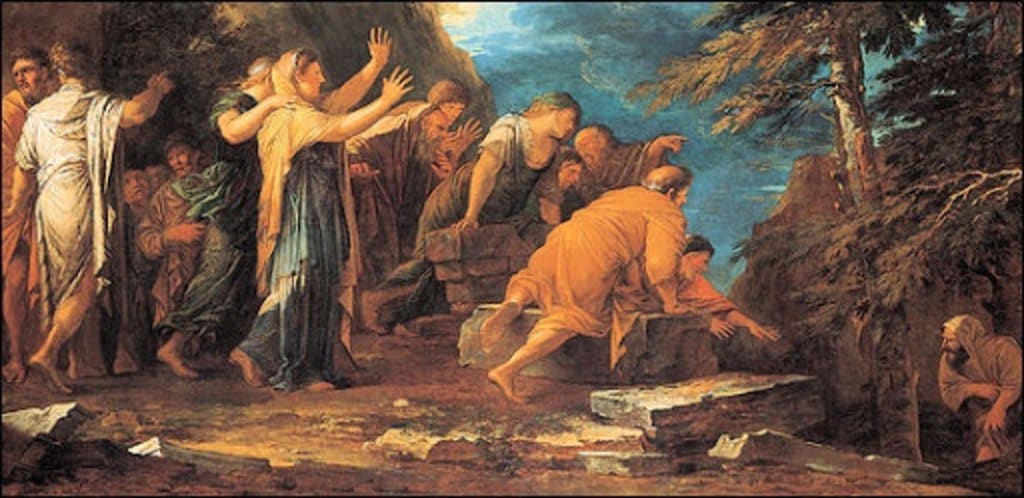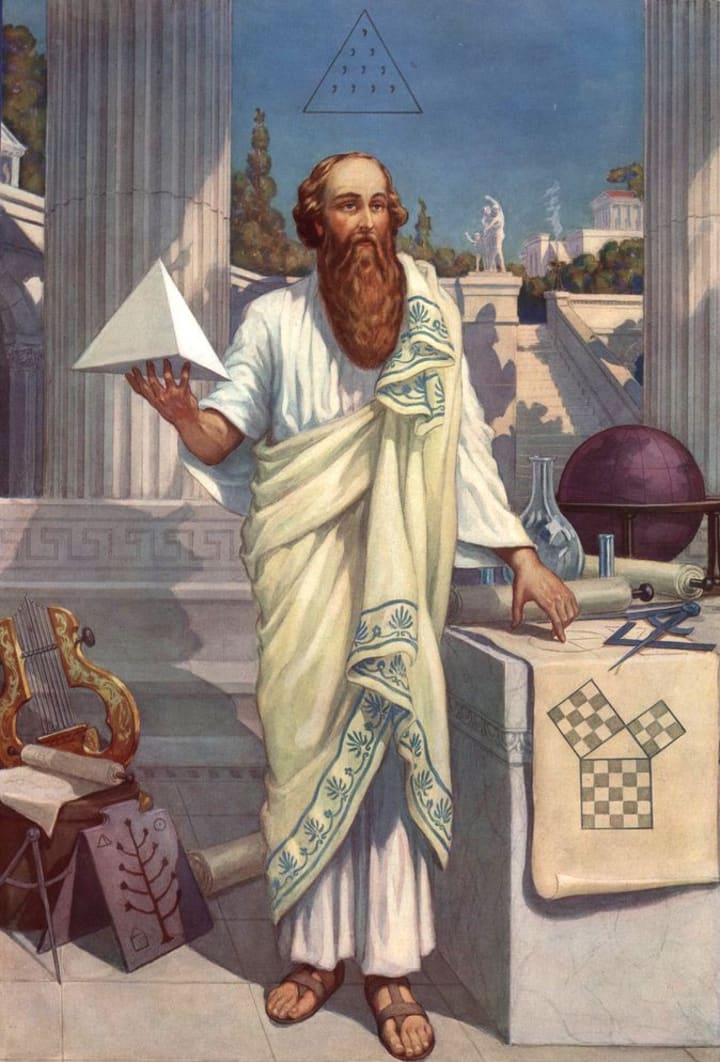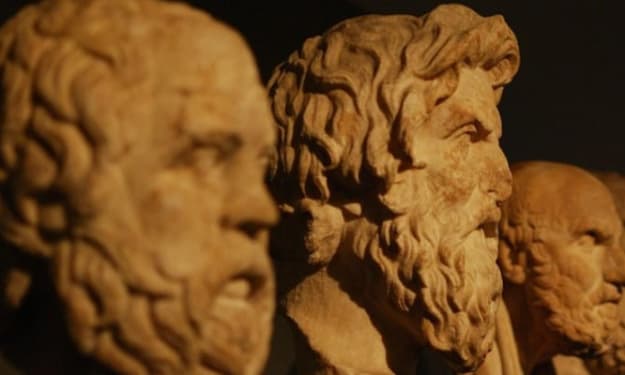The Pythagoreans
kosmos, harmonia and number

The Pythagoreans or The Italians were a group of philosophers who belonged to an ancient sect that brought forward the Pythagorean tradition and doctrines, which in turn brought developments in the fields of science, religion and philosophy. Among the Pythagoreans, such as Hippasus, Petron, Ecphantus, Hicetas, Philolaus, Archytas; Pythagoras is the most familiar and well known, who was a mathematician, religious and cultural leader, a Guru and a philosopher.

In some accounts, Pythagoras is also referred to as a superhuman figure. Thus, we find a mist of obscurity veiling the legendary character of Pythagoras and in turn the history of the Pythagoreans. The sense of obscurity also arises because there are no surviving writings of Pythagoras and that the earliest sources of Pythagorean doctrines are found in the works of Plato and Aristotle. However, the first Pythagorean whose fragmentary writings are still preserved is Philolaus. Philolaus was a contemporary of Socrates whereas Pythagoras was a contemporary of Anaximenes.
The Pythagoreans apart from the speculative philosophy were also engaged in practicing a certain way of life. They were influenced by the nature of man and of the human soul. They were the first presocratics to put forward the philosophy of immortality and metempsychosis.
They had their own set of beliefs and disbeliefs. Unlike the Milesians, Pythagoreans believed in number theory and believed numbers to be the arche, the beginning of everything. They held the view that everything that exists in nature was in fact made of the elements of numbers and that everything in the universe was manifested in numbers. Their interest however was not limited to numbers alone. They took a keen interest in music as well. As a result of their interest in numbers and music, the discovery of the ratios between the notes of the musical scale came into being. The discovery being that the notes of the musical scale are expressed in fixed ratios. The term kosmos was first used by Pythagoras for the universe. This Greek word refers to the prevailing order and beauty of the universe instead of disorder and randomness. They believed that the universe was a cosmos because the different phenomenon that took place in nature betrayed geometrical forms and proportions. These definite proportions that existed in nature helped the things to unfurl in efficient and magnificent ways. They tried to base their explanations for everything in terms of numbers either as a whole or in proportions. The numbers for them were like patterns or codes that were the basic structural and functional units of existence.
The fragment B41 , gives us an insight about how the Pythagoreans saw the universe as a Harmonia and a number. It states that “Those called Pythagoreans applied themselves first to mathematics and were the first to develop this science; and through studying it they came to believe that its principles are the principles of everything.” This statement hints at the idea that the Pythagoreans studied the nature and the universe in terms of numbers. They deciphered the hidden patterns of the kosmos in terms of numbers. They sought out for the latent phenomena of the universe in terms of ratios and proportions. They started to attribute numbers to things. Just like the mathematical ratios in the notes of music, they established a relation between body and numbers. Further stating fragment B4, “…and since they saw, further that the properties and ratios of the musical scales are based on numbers, and since it seemed clear that all other things have their whole nature modelled upon numbers, and that numbers are the ultimate things in the whole physical universe, they assumed the elements of numbers to be the elements of all things, and the whole universe to be a proportion [harmony] or number”. The Pythagorean tradition started to study mathematics and music as if they were the two sides of the same coin. And thus, as Plato says, “they call music and mathematics sister sciences” 2 Their approach was different from their predecessors. They held the notion that from number arises proportion and proportion in turn give rise to harmony.3 In case of Pythagorean tradition, harmonics means the explanation of the musical intervals in terms of musical ratios. The other thing to note is that Aristotle attributes to the Pythagoreans the view that soul is a harmony. Harmony is the transliteration of the Greek word Harmonia, which means fitting or joining together4. Thus, they believed soul to be a harmony I.e. they considered soul to be a mixture of bodily elements in a definite proportion in the same way as they considered nature to be a mixture of number elements. By attributing harmonica to soul and by combining the idea of harmony with the relationship between the fixed proportions of music just like the bodily elements, the Pythagoreans hint at the kosmos in terms of harmonica and number.

Similarly, from the fragments B13 and B14 which state “things are numbers” and “things imitate numbers”, we infer that they formed numbers as the basis of the kosmos. They started to attribute numbers to even abstract and inanimate matters, like justice and suffering. According to them, number 4 represented Justice because it was (‘a square in which each of the two factors treat the other as the other treats it’)5 It is also noted that they named the harmonic scales, which were a fixed ratio between first four integers, as the ‘tetractys’. Numbers were also used by the Pythagoreans to establish and construct a cosmology on lines which were similar to those of the Milesians, except for the fact that the Pythagoreans spoke of numbers (I.e. odd and even) as the basis of generating one other whereas the Milesians talked of an abstract source called unity. The involvement of numbers in Pythagoreans’ idea of kosmos is also reflected by the ‘table of opposites’ provided by them. This list consists of only ten things of opposite character because for them ten represented a canonical number. For them the idea of limited and unlimited also revolved around numbers as they considered even number to be limited and odd to be unlimited. There were several explanations for why a certain thing was limited and the other was not and many of them are ambiguous.
Pythagoreans, nevertheless great mathematicians, were mostly an obscure sect as stated earlier. But their doctrines and teachings gained a widespread recognition which is very well known till the present day. Not to mention the famous Pythagorean theorem, that established relation among the three sides of a right triangle. Every group of philosophers that flourished through a certain period of time in history had its own way of studying nature and its own way of speculation. They had their own perspectives and way of connecting links of the cosmos. And for the Pythagoreans it was the ‘harmonia’ and ‘number’ that steered their perspective and way of studying kosmos in a specific way that we know of today.
References
1 Aristotle, Metaphysics 985b 32ff
2 Republic 531b-c
3 science.jrank.org /pages/10928/Pythagoreanism-Number-Cosmos-Harmony
4 Ancient Greek Philosophy by Vijay Tankha (Pg 97)
5 Ancient Greek Philosophy, Vijay Tankha (Pg 109)
Bibliography
Guthrie, W. K. C. A History of Greek Philosophy. Vol. 1: The Earlier Presocratics and the Pythagoreans.
Cambridge, U.K.: Cambridge University Press, 1962.
Vijay Tankha, Ancient Greek Philosophy, Thales to Socrates
Charles H Kahn, Pythagoras and the Pythagoreans, a brief history
G.S Kirk & J. E Raven, The Presocratic Philosophers
Guthrie, Kenneth S., and David R. Fideler, eds. The Pythagorean Sourcebook and Library: An Anthology of Ancient Writings which Relate to Pythagoras and Pythagorean Philosophy. Grand Rapids, Mich. Phanes Press, 1987






Comments
There are no comments for this story
Be the first to respond and start the conversation.